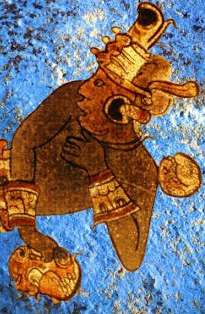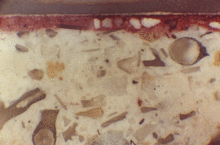Maya blue
| Maya blue | |
|---|---|
 A warrior with azul Maya on the background | |
| Hex triplet | #73C2FB |
| sRGBB (r, g, b) | (115, 194, 251) |
| HSV (h, s, v) | (205°, 54%, 98%) |
| Source | http://www.colorhexa.com/73c2fb |
|
B: Normalized to [0–255] (byte) | |
Maya blue (Spanish: azul maya) is a unique bright azure blue pigment manufactured by cultures of pre-Columbian Mesoamerica, such as the Maya and Aztec.
Manufacture
The Maya blue pigment is a composite of organic and inorganic constituents, primarily indigo dyes derived from the leaves of añil (Indigofera suffruticosa) plants combined with palygorskite, a natural clay which, mysteriously, is not known to exist in abundant deposits in Mesoamerica.[1] Smaller trace amounts of other mineral additives have also been identified.[2]
Historical use
Maya blue first appeared around 800, and it was still used in the 16th century in several Convents of Colonial Mexico, notably in the paintings of the Indian Juan Gerson in Tecamachalco. These paintings are a clear example of the combination of Indian and European techniques sometimes known as Arte Indocristiano. After that, the techniques for its production were lost in Mexico, but in Cuba there are examples from as late as 1830.[3]
Resistance to weathering
Despite time and the harsh weathering conditions, paintings colored by Maya blue have not faded over time. More remarkably, the color has resisted chemical solvents and acids such as nitric acid. Recently, its resistance against chemical aggression (acids, alkalis, solvents, etc.) and biodegradation was tested, and it was shown that Maya blue is an extremely resistant pigment, but it can be destroyed using very intense acid treatment under reflux.[4]
Research on chemical composition



The chemical composition of the compound was determined by powder diffraction in the 1950s[5] and was found to be a composite of palygorskite and indigo, most likely derived from the leaves of the añil. An actual recipe to reproduce Maya blue pigment was published in 1993 by a Mexican historian and chemist, Constantino Reyes-Valerio. The combination of different clays (palygorskite and montmorillonite), together with the use of the leaves of the añil and the actual process is described in his paper.[6] Reyes-Valerio's contributions were possible due to his combined background of history and chemistry, through a thorough revision of primary texts (Sahagun, Hernandez, Jimenez, and others), microscopic analysis of the mural paintings and fourier transform infrared spectroscopy.
After the formula for the production was published in the book De Bonampak al Templo Mayor: Historia del Azul Maya en Mesoamerica, many developments in the chemical analysis of the pigment occurred in collaborations between Reyes-Valerio and European scientists.[7]
A comprehensive study on the pigment which describes history, the experimental study techniques (diffraction studies, infrared spectroscopies, Raman amplification, optical spectroscopies, voltammetry, nuclear magnetic resonance, and computer modelling), the syntheses, properties and nature of Maya blue and the research in relation with the archaeological and historical contexts has been published in the journal Developments in Clay Science.[8]
Uses in cultural contexts
Pre-Columbian American culture
- In the Americas, Maya blue was used as a colorant in pre-Columbian artworks, sculptures, murals, and textiles (probably), and to illuminate Mesoamerican codices. Recent research also suggests Maya blue may have played an important role in human sacrifices to Chaac at Chichén Itzá, both produced at the sacrificial site and used to paint the bodies of the victims.[9]
See also
- Other classic artificial blue pigments: Egyptian blue, Chinese blue
- List of colors
References
- ↑ Arnold (2005); Haude (1997).
- ↑ Haude (1997); Reyes-Valerio (1993).
- ↑ Chiari (2000)
- ↑ Sanchez del Rio(2006)
- ↑ Gettens, R. J. Am. Antiq. 1962, 27, 557–564
- ↑ Reyes-Valerio, De Bonampak al Templo Mayor, La historia del Azul Maya en Mesoamerica, Siglo XXI Editores, 1993.
- ↑ notably, Giaccomo Chiari from the University of Torino, David Ajò from C.N.R. of Padua and Manuel Sanchez del Rio from ESRF in France
- ↑ Sanchez del Rio, et al. The Maya Blue Pigment, Developments in Clay Science, Vol. 3., Pages 453–481, doi:10.1016/B978-0-444-53607-5.00018-9
- ↑ Greg Borzo's press release, 26-Feb-2008 (update when the actual study comes out)
- Arnold, Dean E. (2005). "Maya Blue and Palygorskite:A second possible pre-Columbian source". Ancient Mesoamerica. 16: 51–62. doi:10.1017/S0956536105050078.
- Arnold, Dean E.; Bruce F. Bohor (1975). "Attapulgite and Maya Blue: an Ancient Mine Comes to Light". Archaeology. 28 (1): 23–29.
- Chiari, Giaccomo; R. Giustetto; C. Reyes-Valerio; G. Richiardi (2000). "Maya Blue Pigment: A Palygorskite-Indigo complex". XXX Congresso Associazione Italiana di Cristallografia. 48 (1): 115.
- Chiari, Giaccomo; R. Giustetto; J. Druzik; E. Doehne; G. Richiardi (2008). %7C "Pre-columbian nanotechnology: reconciling the mysteries of the maya blue pigment" Check
|url=value (help). Applied Physics A: Materials Science & Processing. 90 (1): 3–7. doi:10.1007/s00339-007-4287-z. - M. Sánchez del Río; P. Martinetto; C. Solís & C. Reyes-Valerio (2006). "PIXE analysis on Maya blue in Prehispanic and colonial mural paintings". Nuclear Instruments and Methods in Physics Research Section B. 249 (1–2): 628–632. doi:10.1016/j.nimb.2006.03.069.
- M. Sanchez del Rio, A. Sodo, S. G. Eeckhout, T. Neisius, P. Martinetto, E. Dooryhée and C. Reyes-Valerio (2005). "Fe K-edge XANES of Maya blue pigment". Nuclear Instruments and Methods in Physics Research Section B. 238 (1–4): 50–54. doi:10.1016/j.nimb.2005.06.017.
- M. Sanchez del Rio; P. Martinetto; A. Somogyi; C. Reyes-Valerio; E. Dooryhée; N. Peltier; L. Alianelli; B. Moignard; L. Pichon; T. Calligaro; J.-C. Dran (2004). "Microanalysis study of archaeological mural samples containing Maya blue pigment". Spectrochimica Acta Part B: Atomic Spectroscopy. 59 (10–11): 1619–1625. doi:10.1016/j.sab.2004.07.027.
- Haude, Mary Elizabeth (1997). "Identification and Classification of Colorants Used During Mexico's Early Colonial Period". The Book and Paper Group Annual. 16. ISSN 0887-8978. Retrieved 2007-03-14.
- Reyes-Valerio, Constantino (1993). De Bonampak al Templo Mayor: El azul maya en Mesoamérica (in Spanish). Mexico D.F.: Siglo XXI editores. ISBN 968-23-1893-9. Retrieved 2007-03-16.
External links
- Azul Maya, descriptive site by Reyes-Valerio (Spanish) (English)